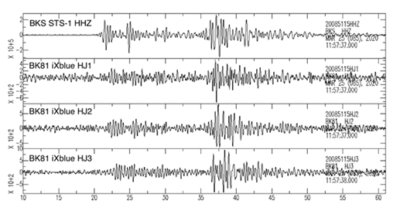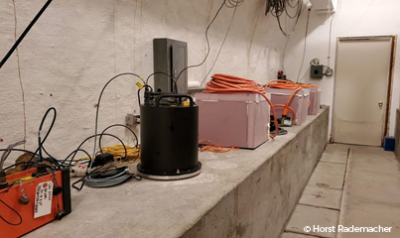Denver – 05/19/2020 – The blueSeis-3A rotational seismometer developed by iXblue, a high-tech company specializing in the design and manufacturing of innovative solutions for navigation, positioning, geophysical and acoustic imaging markets, was recently installed successfully at Berkeley Seismological Laboratory (BSL), in California for evaluation until June 2020.
The System is set-up in the Byerly seismographic vault (part of the regional Berkeley digital seismic network) and is collocated with standard seismometers for 6 degrees of freedom computation. Since its installation late March, blueSeis-3A has captured interesting data from a few earthquakes at local-to-regional distances.

Installed at UC Berkeley in the center of seismically active areas of Northern California, the blueSeis rotational seismometer has recorded several local and regional earthquakes, including a 4.1 magnitude earthquake in the Geysers at a distance of 120 km on its first day of use.
Based on iXblue’s Fiber-Optic Gyroscope (FOG) Technology, blueSeis-3A is revolutionizing the seismology research community. By measuring the rotational movements (yaw, pitch and roll) of the ground, blueSeis sensor allows for a complete measurement of the seismic wave. iXblue’s FOG is the ultimate precision rotation sensor that uses the path of photons through an optical fiber as its sensing element. By using light for the measurement, the FOG is entirely insensitive to linear accelerations and no cross coupling can happen.
The blueSeis-3A unit installed at BSL benefits from new features, including a better timing accuracy, a 12 to 36V power input and an improved data logger with automatic processing and seedlink server (standard for data transmission in seismology) and standard seismic station channel naming through iXblue web MMI. Due to COVID-19 travel restrictions, configuration and training at the BSL was done remotely by the iXblue, Inc. team. The sensor is indeed a truly easy-to-install and plug-and-play solution for seismological labs and networks.
“We are very excited to collaborate with iXblue and to have the opportunity to test the blueSeis-3A sensor in our vault”, states, Dr. Peggy Hellweg, from Berkeley Seismological Lab. “Rotational seismic signals indeed are very interesting and characterizing ground motions from complete six components (Z,N,E, and three rotational comp.) provide additional insight into wave propagation from sources and structures.”
Data availability
Scientists interested to look at the data can contact Dr. Peggy Hellweg at BSL (peggy@seismo.berkeley.edu) or Elliot de Toldi at iXblue Inc. (elliot.de-toldi@ixblue.com).
About iXblue
iXblue is a global leader in the design and manufacturing of innovative solutions devoted to navigation, positioning and underwater imaging, shipbuilding, as well as photonics. Using its unique in-house technology, the company offers turnkey solutions to its customers to carry out their operations with optimum efficiency and reliability. Through its blueSeis product line, iXblue specifically offers unique and reliable fiber-optic solutions that allows comprehensive exploration of rotational ground motions by the measurement of both the translations and rotations of the ground’s movement in the three directions of space.

